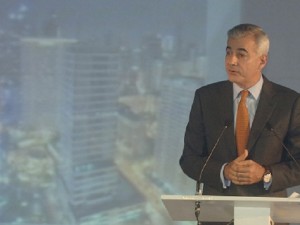Ayala Corp. nets P6.9B
The country’s oldest business house Ayala Corp. boosted its net profit in the first quarter by 20 percent year-on-year to P6.9 billion on robust earnings from banking and real estate businesses.
Equity earnings from various businesses climbed 18 percent year-on-year to reach P8.5 billion, led by earnings contribution from the Bank of the Philippine Islands and Ayala Land, which expanded by 27 percent and 18 percent, respectively.
Ayala’s emerging businesses also posted higher equity earnings, particularly AC Energy and manufacturing vehicle AC Industrials, which expanded profit contribution by 26 percent and 22 percent, respectively.
“We are pleased to see our businesses sustain their positive performance in the first quarter. As a group, we continue to search for value-accretive opportunities not only to create new sources of financial growth, but also to remain relevant to our stakeholders. As our core businesses maintain their growth trajectories, we are encouraged by the progress of our emerging businesses. In particular, our power, infrastructure, and industrial technologies units are pursuing strategic opportunities to scale up and over time bring significant value to our portfolio,” Ayala president and chief operating officer Fernando Zobel de Ayala said.
On its new businesses, the conglomerate reported that sustained operating efficiencies of its power assets had driven AC Energy’s first quarter net profit by 25 percent year-on-year to P313.7 million. This growth was achieved despite the annual maintenance for AC Energy’s conventional energy assets, South Luzon Thermal Energy Corp. and GNPower Mariveles, which was scheduled during the period.
The infrastructure business has likewise started contributing profits to the group. AC Infrastructure
reported a net income of P9 million for the first quarter. AC Infrastructure continues is involved in these three public-private partnership projects:
– Light Rail Manila Corp., which manages and operates LRT 1, increased average daily train trips to 471 from 462 during the same period in 2016. It averaged close to 445,000 daily riders for the first three months;
– The Muntinlupa-Cavite Expressway averaged close to 28,000 vehicles per day, up 29 percent year-on-year;
– The “Beep” ticketing system now has close to 3.1 million cards in circulation since its launch in 2015.
AC Industrials recorded P332 million in net income, 22 percent higher from the previous year, attributed to the robust performance of both its electronics manufacturing and automotive retail businesses.
This industrial unit includes Integrated Micro-Electronics Inc., which reported a 33-percent rise in first quarter net profit to $8.7 million on strong sales growth and better gross profit margins.
AC Industrials’ automotive business also recorded a 10 percent growth in first quarter to net income to P117 million, on robust sales of its Honda BR-V and Civic models. Revenues rose by 37 percent to P7.6 billion driven by strong demand across all brands.
In healthcare, Generika’s revenues grew by 10 percent year-on-year to P746.9 million driven by higher distribution and retail sales. As of the first quarter, Generika had a footprint of 684 stores nationwide.
It was earlier reported that the following Ayala units performed in the first quarter year-on-year as follows:
– Ayala Land posted P5.6 billion in net income, 18 percent higher year-on-year on the continued expansion of its property development and commercial leasing businesses;
– Bank of the Philippine Islands saw its net income surging by 26 percent to P6.3 billion, buoyed by the consistent performance of its core lending business alongside higher fee-based businesses, gains from securities trading and property sales.
– Globe Telecom’s net profit declined by 13 percent to P3.8 billion due to higher depreciation, interest expense and costs related to the strategic acquisition of San Miguel’s telecom assets;
– Manila Water’s net profit declined by 2 percent to P1.4 billion attributed to higher costs from new investments and expansion initiatives.

